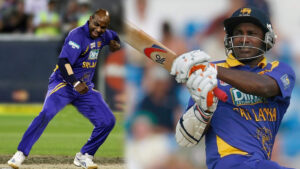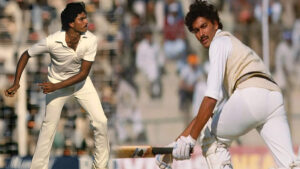
From Spinners to Batting Stars

The cricketing landscape is adorned with tales of versatility, where players make magic with both bat and ball. And sometimes, some players make remarkable transitions when their raw talent finds its true calling, helping them climb further on the ladder of success. Today, we celebrate five such cricketers who began their careers as bowlers but eventually settled as Batters.
Steve Smith

Drafted as a leg-spinner, Steve Smith’s journey took an interesting turn when he found himself batting at number 3 for Australia. Imagine being picked for your bowling, but then becoming one of the best batsmen in the world! That’s Steve Smith’s story. He started as a leg-spinner but soon found his calling with the bat.
Some initial comparisons to Shane Warne hinted him as a bowling all-rounder, but it was the 2013 Ashes series in England that made sure his stance as a batter. He scores tons of runs and confuses bowlers with his unique technique. Now, he’s part of the “Fab Four” of modern cricket, a group of amazing batsmen!
Sanath Jayasuriya

Sri Lanka’s gem, Sanath Jayasuriya, started as a left-arm spinner. While his early years saw him contribute with both bat and ball, his true potential unfolded when he was promoted as an opener. Jayasuriya is one of the legends to have a triple century in the test format.
Jayasuriya’s transformation not only put him to legendary status but also revolutionized the way the game was approached at the highest level. Jayasuriya went on to become the second batsman to score 13,000 runs in ODIs after Sachin Tendulkar. He was also named as the Most Valuable Player in the 1996 ICC Cricket World Cup.
Ravi Shastri

When the 17-year-old Ravi Shastri debuted for Mumbai, he was a left-arm spinner batting at number 10. Ravi Shastri made his Test debut in 1981 as a lower-order hitter and left-arm spinner who came to bat at number 10. With an unwavering dedication to perfect his batting, he opened the innings for India 18 months later. Shastri’s story proves that talent can blossom in unexpected ways. The former Indian coach played 80 Tests with 11 centuries and 150 ODIs with four centuries respectively.
Shoaib Malik

Malik’s international career began at 17 as an off-spinner against West Indies. While he showcased his batting prowess with a Test hundred against New Zealand, it was his aggressive middle-order batting that stole the show. He has scored 7534 runs in 287 ODIs at an average of 34.56 and has scalped 158 wickets. Malik was recognized as a better batsman than a bowler as his career progressed hinting at his remarkable transition.
Shahid Afridi

Remember the fastest hundred in ODI? Yeah, that was Afridi. Drafted for his leg-break bowling at 16, Afridi’s story took a dramatic turn after he score hundred in ODI in just 37-ball against Sri Lanka. Afridi soon became one of the most feared hitters in the game. Afridi’s 8064 ODI runs at a strike rate of 117.01 speak volumes about his batting metamorphosis. Although he could still bowl well, his batting took center stage, making him a true cricketing legend.
These cricketers inspire us to be open-minded when exploring our talents, challenge boundaries. Who knows might be seeing more players in the list.
-

Best Bowling Figures in IPL History
• 21 Mar, 24 • by InkspilledThe Indian Premier League (IPL) is a cricket tournament loved by many for its exciting matches. While everyone loves big runs, bowlers are just as important for winning games. And not only to win the title, but these quality bowlers are also responsible for completely changing the match and tilt it in the favour of his team. Here's a look at some of the most impressive bowling performances in IPL history:
-

Rohit Sharma Becomes First Batter to Hit 600 Sixes in International Cricket
• 07 Jun, 24 • by InkspilledRohit has achieved a personal landmark – becoming the first batter ever to smash a phenomenal 600 sixes in international cricket!
-

The WPL’s Top Run Scorers: Unveiling the Batting Powerhouses
• 28 Feb, 24 • by InkspilledThe Women's Premier League (WPL) isn't just about thrilling catches and fiery pace bowling - it's also a stage for exceptional batting displays. Players compete to become the leading run-scorer, making every match a battle for individual glory. Let's delve into the top 10 batters who have dominated the WPL with their consistent.

